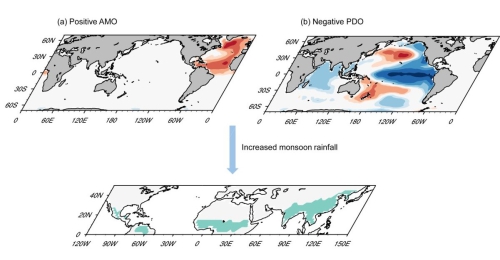Near-term projection of rainfall requires understanding of the roles of the internal variability and external forcings on modulating the interdecadal variations of rainfall. The sea surface temperature (SST) anomalies over the North Atlantic and tropical Pacific can explain the interdecadal variations of monsoon rainfall during the 20th century, according to a recent study published in Journal of Climate.
The changes in monsoon rainfall have enormous impact on social and economic development over the monsoon regions which sustain more than two-thirds of the world's population. Observations show interdecadal variations in global land monsoon rainfall during the 20th century, with an increasing trend from 1901 to 1955 followed by a weakening trend in the later half century, which is mainly contributed by the Northern Hemisphere summer monsoon (NHSM). However, the mechanisms governing the above changes remain inconclusive.
To investigate the physical mechanisms behind the interdecadal variations, researchers used the outputs of two atmospheric general circulation models (AGCMs) forced by historical SST covering the 20th century. "AGCMs have been shown to be favorable for understanding global and regional rainfall variability," introduced JIANG Jie from the Institute of Atmospheric Physics(IAP) of the Chinese Academy of Sciences, the paper's first author. "The coincident interdecadal variations of monsoon rainfall in AGCM simulations compared with observation demonstrate the modulation of decadal SST changes on the long-term variations in monsoon rainfall."

Sea surface temperature anomalies over North Atlantic and tropical Pacific can modulate the changes in monsoon rainfall. (Image by JIANG Jie)
The team further performed the moisture budget analysis to understand the physical process. They found that the dynamic term associated with the atmospheric circulation changes is prominent for the interdecadal variations in monsoon rainfall, while the thermodynamic term associated with humidity changes lead to coincident wetting over the monsoon domain during both two periods. The increase of NHSM land monsoon rainfall during 1901-1955 is associated with the strengthening of NHSM circulation and Walker circulation, and vice versa for the period from 1956 to 1990. The interdecadal variations of global monsoon circulation are driven by the changes of sea surface temperature over the North Atlantic and the Pacific. A warmer North Atlantic, together with a colder eastern tropical Pacific and a warmer western subtropical Pacific, can lead to a strengthened meridional gradient in mid-to-upper-tropospheric thickness and strengthened trade winds, which transport more water vapor into monsoon regions, leading to an increase in monsoon rainfall.
"The results of AGCM simulations can help us understand the prominent role of internal SST decadal changes on global monsoon rainfall. However, we should not preclude the impacts of external variability. Numerical simulations and previous studies have shown evidence that anthropogenic aerosols and greenhouse gases can lead to the changes in monsoon rainfall." commented Prof. ZHOU Tianjun, corresponding author on the paper and senior scientist at the IAP. "Further efforts should be devoted to understanding and distinguishing the external forced and internally driven changes in monsoon rainfall, which is also one of the tasks of the Coupled Model Intercomparison Project phase 6 (CMIP6) Global Monsoon Modeling Intercomparison Project (GMMIP)," Zhou added.
Citation: Jiang Jie, Tianjun Zhou*, 2019: Global monsoon responses to decadal sea surface temperature variations during the twentieth century: Evidence from AGCM simulations. Journal of Climate, 32, https://doi.org/10.1175/JCLI-D-18-0890.1
Media contact: Ms. LIN Zheng, jennylin@mail.iap.ac.cn
